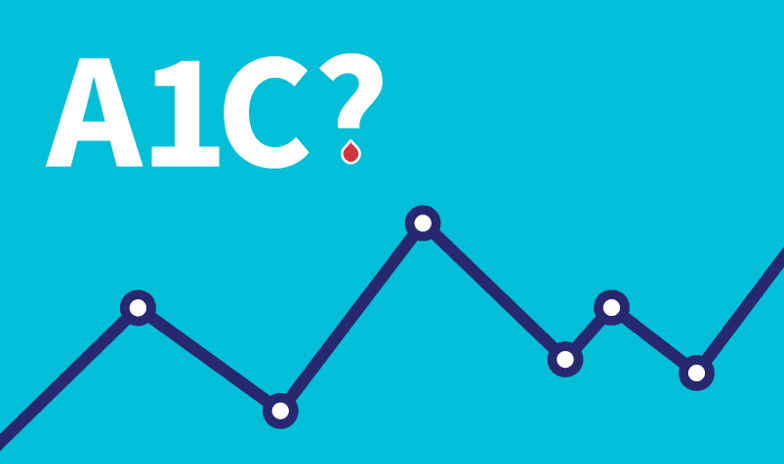What is A1C?
Hemoglobin A1C, also called A1c, HbA1C, or glycated hemoglobin, is the part of red blood cells that have glucose attached.1 It gets reported as a percentage.
What does the A1C test measure?
The A1C test measures the average glucose level over the past three months. Think of it as a 24/7 video of all of the ups, downs and in between of glucose levels. It gives you an idea of how well your body is managing glucose.
The A1C test is different than a blood glucose monitor check or continuous glucose monitors. These devices give you the glucose level at that exact moment in time.
Using A1C, along with day-to-day glucose results is a good way of measuring how well diabetes is being managed.
What’s the recommended A1C for people with diabetes?
The American Diabetes Association (ADA) recommends an A1C goal of <7% in most adults (not pregnant). Some healthcare providers may recommend an A1C of <6.5%, if they can maintain it without adverse effects or events, such as frequent hypoglycemia.2
An A1C of <8% is also thought to be appropriate for people:
- with a history of hypoglycemia (low glucose levels)
- limited life expectancy
- advanced complications
- or other complexities of life.2
We recommend that you discuss your personal target goals with your care team.
How often should I measure A1C?
ADA’s recommendation for measuring A1C is at least two times a year. This recommendation is for those that are currently meeting their treatment goals. If you’re not meeting treatment goals, A1C should be checked quarterly.2
Is there a relationship between A1C and glucose control?
Yes, you can convert A1C to glucose levels.
In the chart below, the first column is the A1C result. The second column shows what the average glucose level was over the past three months. The third column shows the range of glucose levels.
Relate A1C Results to Glucose Levels
| A1C (%) | Estimated Average Glucose (mg/dL) | Glucose Levels Between (mg/dL) |
| 5 | 97 | N/A |
| 6 | 126 | 100 – 152 |
| 7 | 154 | 123 – 185 |
| 8 | 183 | 147 – 217 |
| 9 | 212 | 170 – 249 |
| 10 | 240 | 193 – 282 |
| 11 | 269 | 217 – 314 |
| 12 | 298 | 240 – 347 |
For example, an A1C of 8% would mean your average glucose over the past three months was 183 mg/dL. And likely over that three month period, your glucose levels would have ranged from 147 mg/dL to 217 mg/dL.
Is the A1C test accurate for everyone?
Since the A1C test has been made available (about 40 years), is has become a common way to measure glucose control. However, in the last several years some questions have been raised about potential limitations of A1C:
- Is the A1C accurate for everyone?
- It may not be accurate for some people, including people of African-American descent, people with liver and kidney disease, or with some anemias and sickle cell disease.
- How much detail does the test give?
- It doesn’t give a detailed perspective. The test shows overall trends but does not give same level of details as daily glucose checking.
Can A1C be used to diagnose prediabetes and diabetes?
Yes, in 2010, the ADA endorsed the use of the A1C test as a way to diagnose prediabetes and diabetes.4
The table below provides the A1C levels at which prediabetes and diabetes can be diagnosed.1
| Diagnosis | A1C Level |
| Non-diabetes | Below 5.7% |
| Prediabetes | 5.7 – 6.4% |
| Diabetes (type 1 or 2) | 6.5% or above |
Why is keeping A1C in a healthy range so important in diabetes care?
Numerous studies conclude that keeping A1C in the desired range can help reduce complications of diabetes.
Diabetes complications that can be delayed or prevented are:2
- high blood pressure
- decreased blood circulation
- heart attacks
- strokes
- diminished eyesight or blindness
- nerve damage
What is the cost benefit of lowering A1C?
Recently the ADA published analysis diabetes costs. They showed total estimated costs of $327 billion with $237 billion on direct costs and $90 billion in indirect costs.5 Economic costs of diabetes continues to rise.
Data from numerous studies show that better A1C results in lower total healthcare costs.6 A study using claims data from a large health maintenance organization showed that the group of mainly type 2 patients whose A1C was lowered by 1% experienced lower total health care costs in the range of $685 to $950 less per year compared to people who had no A1C improvement.
Another analysis from a large managed care organization showed that total diabetes-related costs for people whose A1C was greater than 7% was $1,540 per patient during the 1-year follow-up. This was 32% higher than the total diabetes-related costs for people whose A1C was at or below 7%.
References
- Section 1 The A1C Test & Diabetes. https://www.niddk.nih.gov/health-information/diabetes/overview/tests-diagnosis/a1c-test
- Section 2 American Diabetes Association. 6. Glycemic targets: Standards of Medical Care in Diabetes -2018. Diabetes Care.2018;41(Supp 1):S55-S64.
- Section 3 National Glycohemoglobin Standardization Program (NGSP). Harmonizing Hemoglobin A1c Testing. 2010 https://www.ngsp.org/A1ceAG.asp.
- Section 4 American Diabetes Association. 2. Classification and diagnosis of diabetes: Standards of Medical Care in Diabetes -2018. Diabetes Care.2018;41(Supp 1):S55-S64.
- Section 5 American Diabetes Association. Economic Costs of Diabetes in the U.S. in 2017. Diabetes Care. 2018;41(5):917-928.
- Section 6 Hirsch JD, et al. Estimated Cost-Effectiveness, Cost Benefit, and Risk Reduction Associated with an Endocrinologist-Pharmacist Diabetes Intense Medical Management “Tune-Up” Clinic. J Manag Care Spec Pharm. 2017;23(3):318-326. https://www.jmcp.org/doi/full/10.18553/jmcp.2017.23.3.318.




